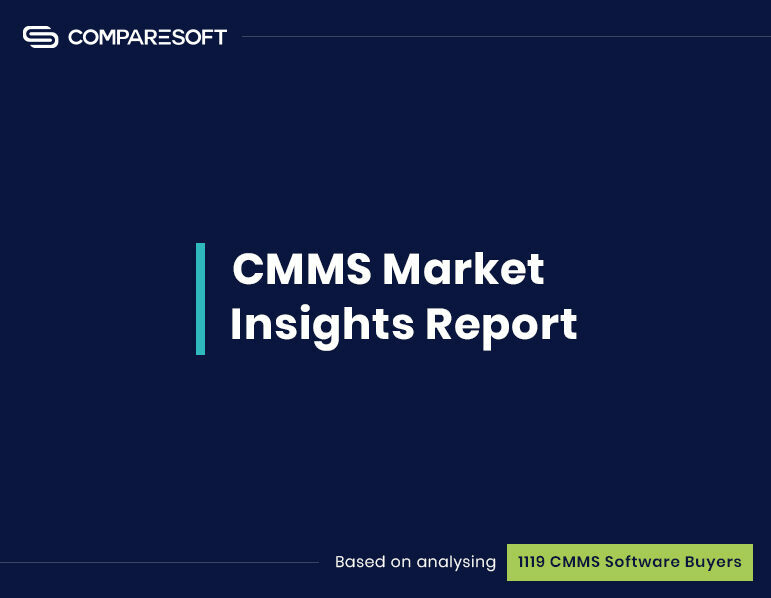
It’s been a strange couple of years for both CMMS vendors and users. Mainly due to the contradictions between widespread disruption and the continuation of operations as usual.
Throughout this period of new normality, Comparesoft continued to work closely with its existing partners and match CMMS Software buyers with solutions that met their unique requirements. Now that 2021 is over, however, we’ve had a chance to look back and to look forward.
We’ve analysed the requirements we’ve seen from CMMS buyers, as well as the industries they’re coming from and the roles they occupy. We’ve also synthesised research, data and collaborations to outline our projected market changes and opportunities moving forward. This is a summary of what we’ve found:
- CMMS User Requirements: CMMS Software buyers are, on average, using paper-based, spreadsheet-based or manual processes to manage up to five hundred jobs per month. They’re looking for flexible, accessible systems with excellent fundamental competencies that can be deployed quickly and support up to twenty-five people.
- CMMS User Industries and Roles: Most CMMS buyers come from manufacturing or industries with strong facility, property and real estate management components. The majority occupy mid-tier or senior, executive or leadership roles, as opposed to field-based or administrative roles.
- CMMS Market Trends: Comparesoft sees two big trends. The first is the continuation of a shift in organisational structures and processes as a result of widespread shift to hybrid working. The second is the stubborn refusal of individuals to abandon spreadsheets despite increasing pressure to move across to consolidated, interconnected platforms.
- CMMS Gaps in the Market: Comparesoft has identified several opportunities. Two are technology-based, involving the usage of AI and AR/VR. One is people-based, involving high-touch pre-sales strategies. The final is a hybrid and involves taking cybersecurity seriously.
The above findings are a synthesis of many things: on-platform data analysis, off-platform research and investigation, Comparesoft’s understanding of CMMS Software, close partnerships with our vendors, and interactions with software buyers. Read on to explore them in more depth.
CMMS User Requirements
Summary: CMMS buyers, on average, have a lot in common. Their teams and departments use complicated, primitive systems—often paper- and spreadsheet-based processes—to manage up to five hundred maintenance jobs per month.
In today’s increasingly demanding and increasingly competitive environment this is becoming unsustainable. The result? They’re seeking an alternative that performs the behaviours and processes they’re used to but faster and more reliably. And they don’t want to spend months and months agonising over the transition.
What they’re really looking for is a CMMS that:
- Excels at the fundamentals
- Has the flexibility to support different asset types and regimes of work
- Isn’t too dissimilar from the look, feel and functions that they’re used to
Of course, there are outliers. There are organisations looking for a CMMS solution compatible with predictive maintenance and moment-by-moment IoT data analysis. There are organisations willing to take more than a year to roll-out a system that will be used intensely by the thousands of people associated with their in-house and external maintenance services.
But most often, CMMS buyers are only concerned with one thing: doing their work well. What they want is a system that supports that and doesn’t get in their way.
Below is a more in-depth breakdown of CMMS user requirements. Please note: the analyses in items one to four are based on additional data analysis beyond the included graphic.
* * *
1. Asset Types
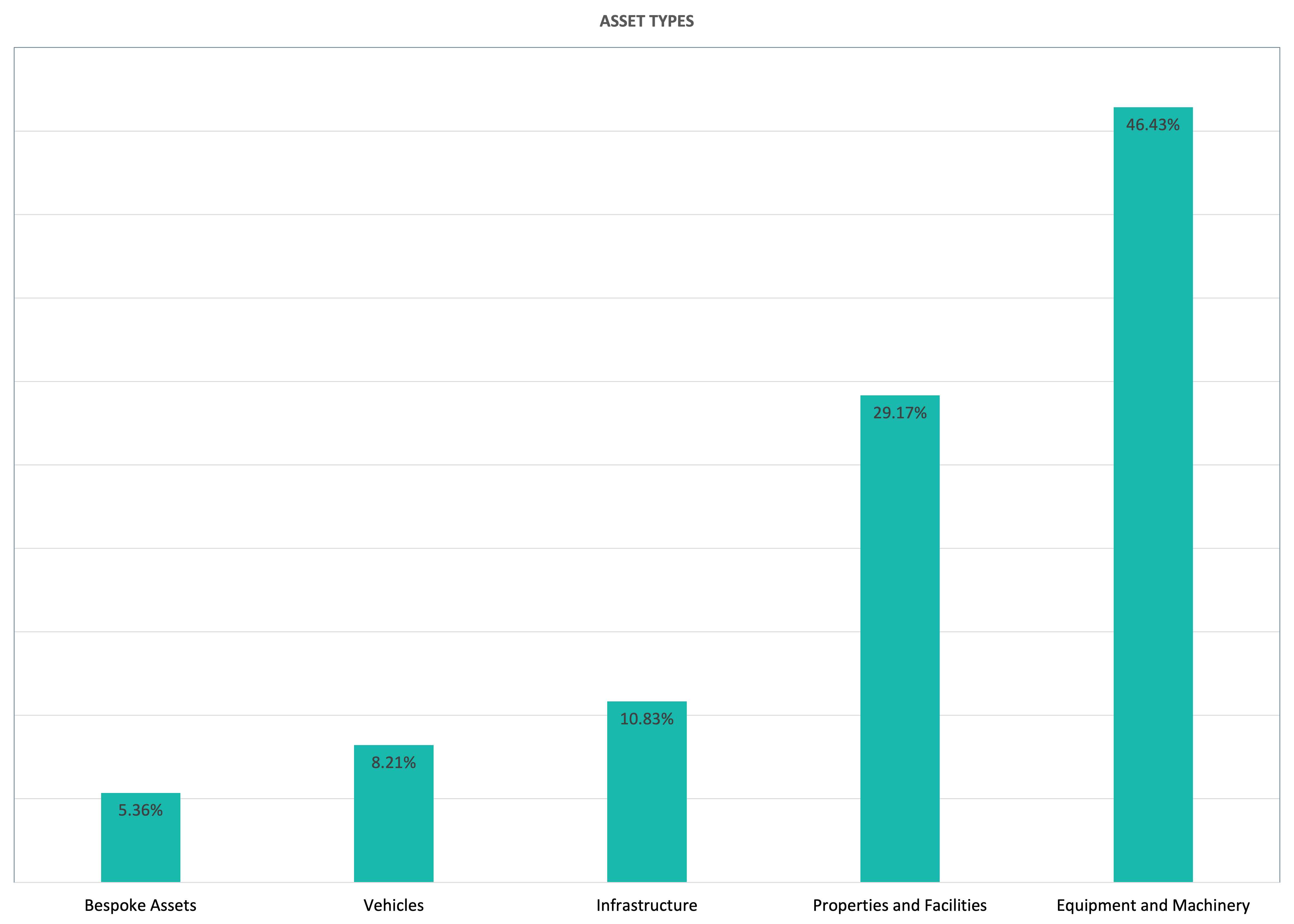
Roughly ~76% of the CMMS users Comparesoft interacted with manage equipment and machinery, whilst ~48% manage properties and facilities. ~28% of the CMMS users encountered by Comparesoft manage both.
~17% of Comparesoft’s CMMS users manage infrastructure assets—such as bridges or road systems—whist ~13% are responsible for the maintenance of various vehicle and fleet assets. ~9% manage bespoke assets, which are assets that defy categorisation as infrastructure, fleet, equipment/machinery or properties/facilities.
Comparesoft also observed that ~9% of CMMS users manage all asset types, and ~12% of CMMS users manage infrastructure, equipment/machinery and properties/facilities.
2. Maintenance Types
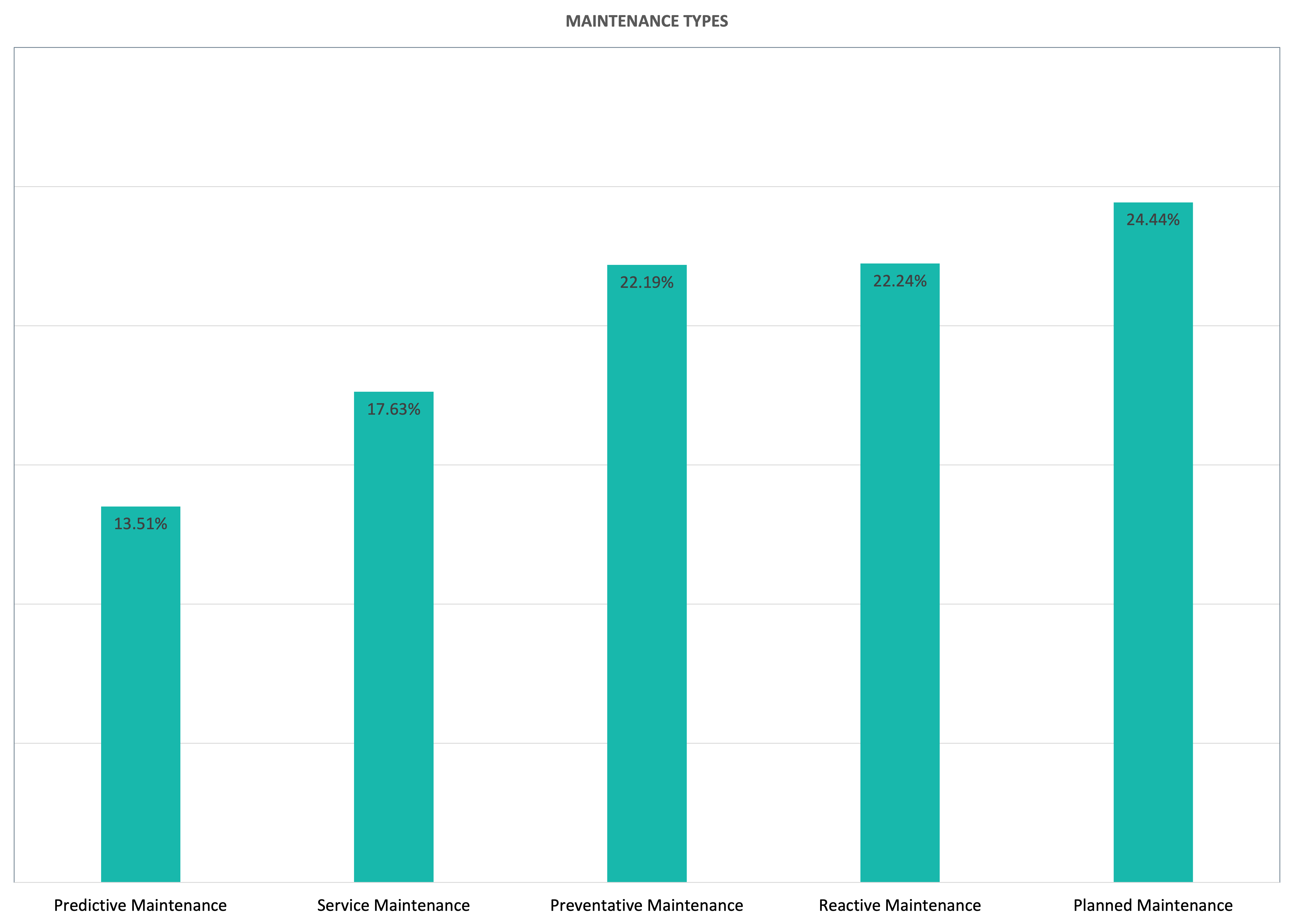
Of the five maintenance types—reactive, planned, preventative, predictive and service—CMMS users, on average, perform at least three. The most popular of these being reactive, planned and preventative maintenance.
~48% CMMS users have some sort of predictive maintenance regime whilst ~36% CMMS users perform all maintenance types. ~63% of CMMS users perform some form of service maintenance whilst ~17% deal exclusively with reactive and planned service maintenance.
3. CMMS Features

CMMS users expect a foundation of core functionality from their systems, with ~79% users indicating they want a way to register assets, log jobs and manage work orders.
On average users selected more than five features, with ~77% indicating they are interested in all listed features except IoT sensor connections and data imports.
H&S and compliance, alongside asset tagging and tracking capabilities, were desired by ~50% of users. ~21% of users were interested only in core CMMS functions: asset tracking, job logging and work order management.
4. Existing Maintenance Management Systems
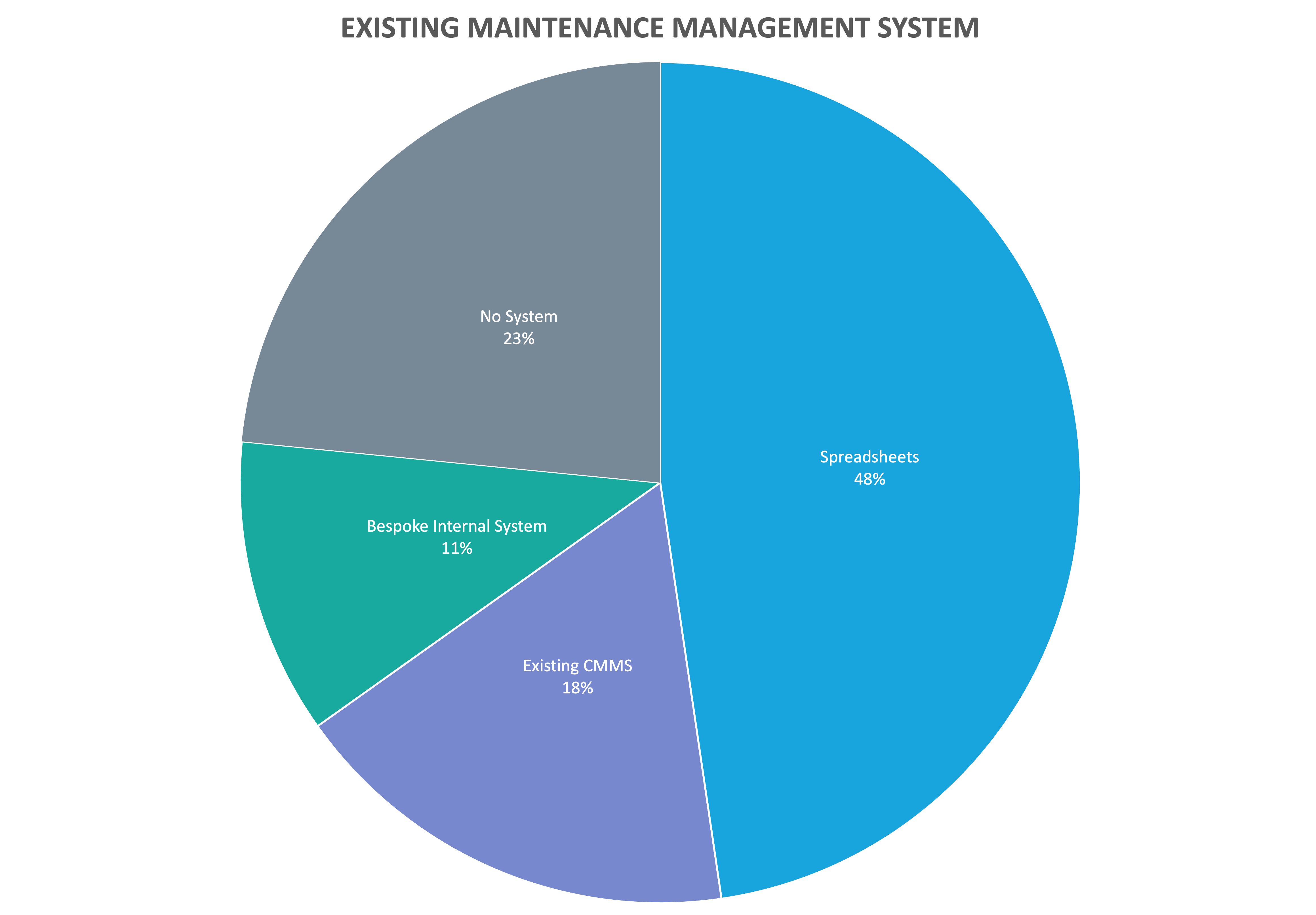
~58% of users seeking a CMMS currently use spreadsheets, with ~28% using no maintenance management system at all. ~14% of users utilise a bespoke internal system and ~21% have an existing system and were seeking a change. ~9% of users relied on spreadsheets in combination with an existing CMMS or bespoke internal system.
5. Work Order Volumes

~85% of users manage less than five hundred maintenance jobs per month. Of that sample, a third manage up to fifty jobs, another third up to one hundred a month, and a third up to five hundred jobs per month.
6. Work Order Types
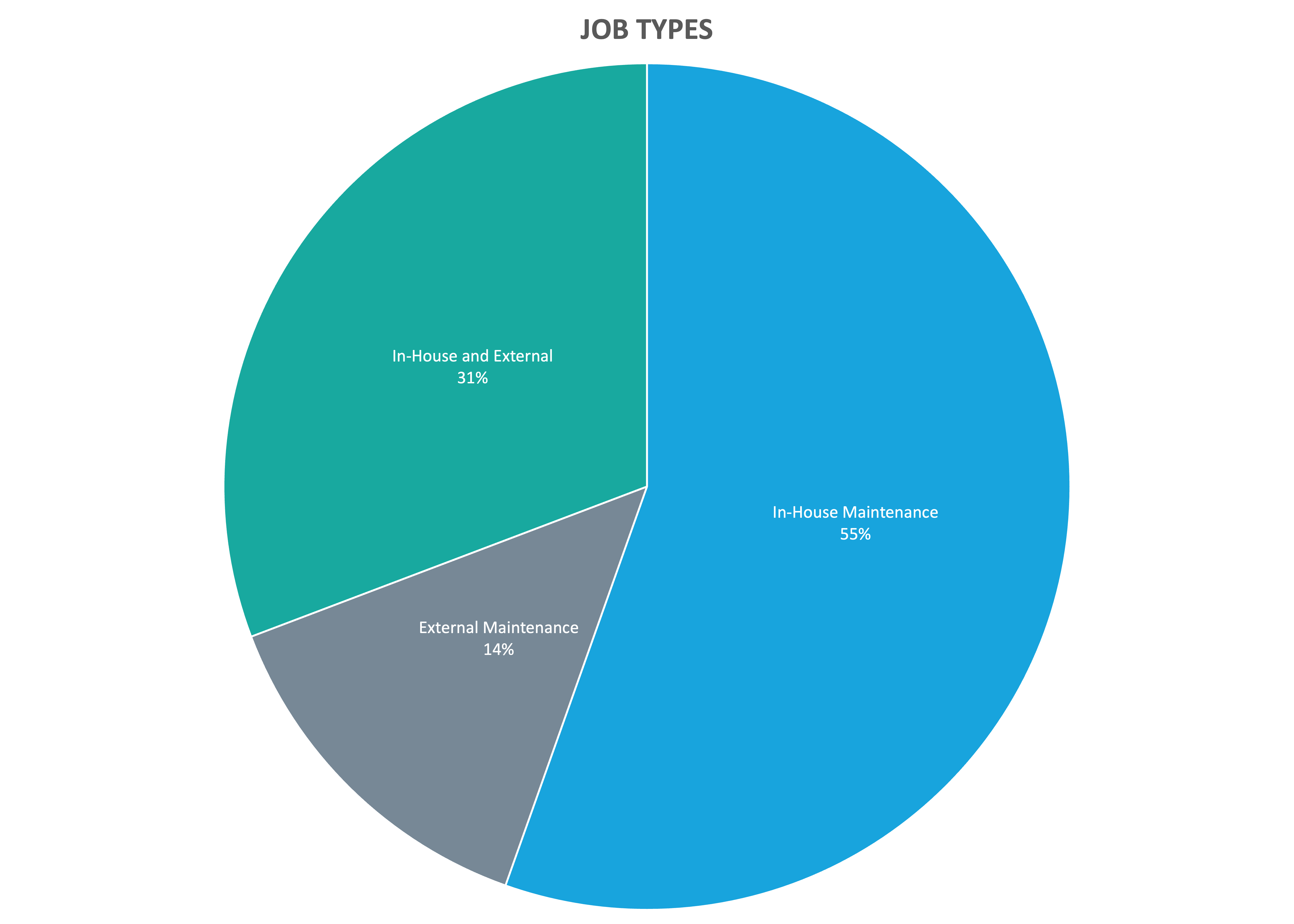
Most users perform either in-house maintenance work (~55%) or a combination of in-house maintenance and work for external customers (~30%). Only ~13% users perform work exclusively for external customers.
7. User Volumes
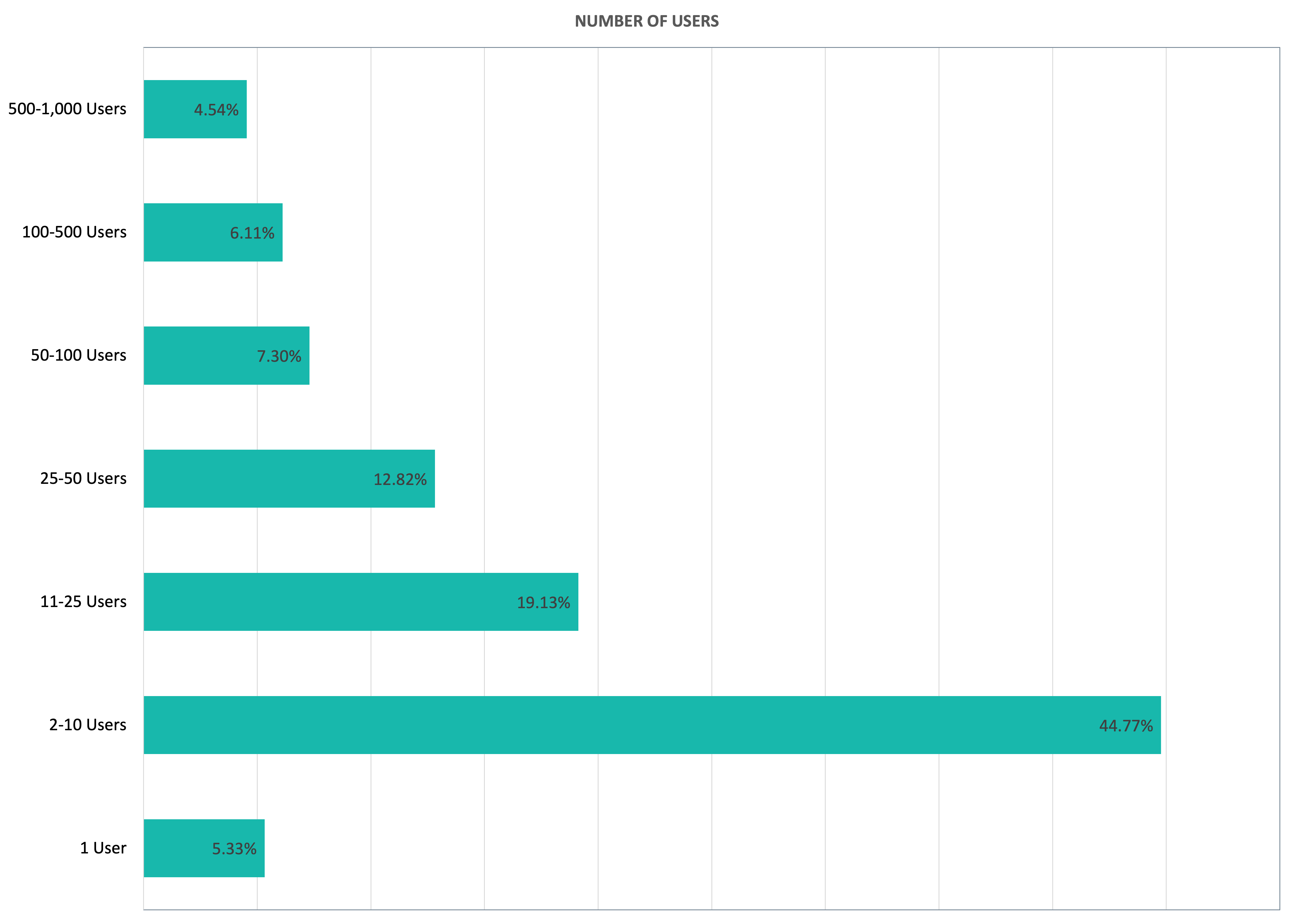
The most popular solution size (~44%) is a CMMS suitable for two to ten users. ~68% of users are looking for a system that supports up to twenty-five users.
~39% of users are seeking a system suitable for up to one hundred users, whilst ~10% users are interested in a system that supports hundreds of users.
~5% users were seeking a one-person system, whilst ~4% of users were seeking a system capable of supporting up to a thousand users.
8. Implementation Timescales

~70% users were either looking to implement a CMMS solution in one to three months (~38%) or expressed uncertainty about what they were looking for an when they wanted it (~31%).
~11% of users were looking to implement in six to twelve months, with ~18% looking to implement in three to six months. Overall, ~67% users had a concrete idea of their implementation timescale.
CMMS User Industries and Roles
Summary: Most buyers encountered by Comparesoft hail from manufacturing (~27%) or are involved in the management and maintenance of facilities, properties and housing (~15%). The full distribution of industries is quite varied, with buyers coming from industries such as oil and gas, education, healthcare, consumer products, foods and beverage, automotive, retail, pharma and chemicals.
Most buyers encountered by Comparesoft share another characteristic: ~80% come from mid-tier or senior, executive or leadership roles. The most common titles we encountered were “Director” (~15%) as well as a few different forms of manager (~39% collectively; engineering, maintenance and project managers).
* * *
1. Industry Distribution
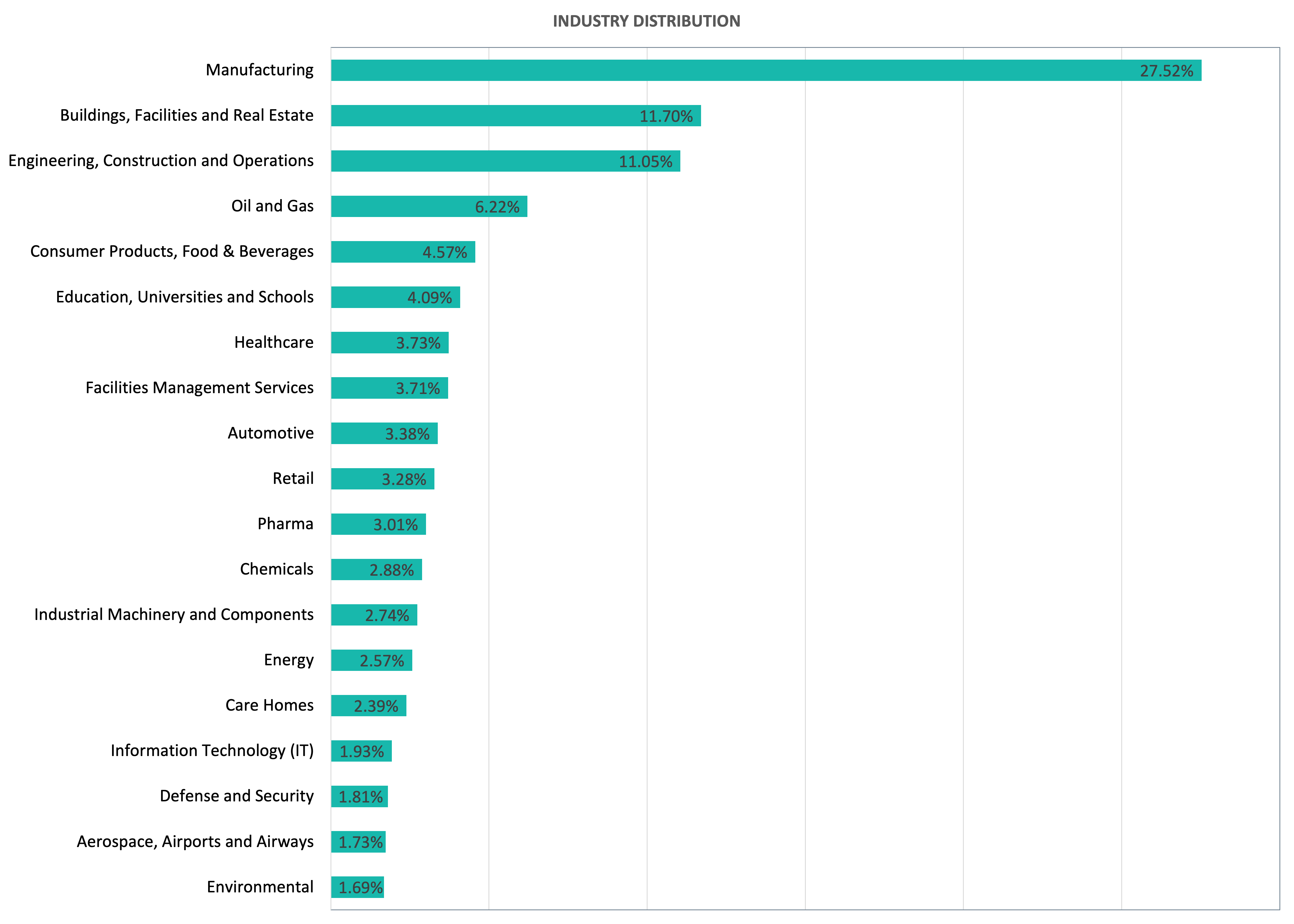
Unsurprisingly, the most represented was manufacturing, with ~27% of users hailing from that sector. The second most popular industry was associated with property, housing and real estate (~12%).
Beyond that, the industries spread out. Engineering, constructions and operations had a strong presence (~11%). Oil and gas was decently represented (~6%) with clusters of users from the education, healthcare, automotive, retail, pharma, chemicals and food and beverage sectors.
2. Seniority Distribution

~48% of CMMS buyers occupy a mid-tier management role within their organisations. ~32% occupy a senior, executive or leadership role. This means that ~80% of CMMS buyers are mid-tier or seniors and have the associated buying authority. Meanwhile, ~20% of users occupy field-based or administrative roles.
3. Role Distribution

“Engineering Manager” was the most popular role (~22%), with engineering, maintenance and project managers accounting, collectively, for ~39% of job roles. “Director” was common, as well, making up ~15% of job roles.
CMMS Market Trends
Comparesoft sees two trends that are of particular importance to CMMS Software vendors. The first is the transition towards hybrid, remote-first work — which is itself a precondition of the ongoing evolution of modern organisations. The second is the continued presence of an often-scorned piece of ubiquitous software: the spreadsheet.
- The Transition to Hybrid, Remote-First Working
- Spreadsheets: “I’m Still Standing…”
- A Contradictory Pattern
- Further Reading
The Transition to Hybrid, Remote-First Working
In On Industrialization: A Technology-Driven Path to the Next Generation Organisation, Simon Wardley lays out key differences between “traditional” and “next generation” organisations.
Wardley explores multiple areas—from structure to sustainability—but preceding any evolution from “traditional” to “next generation” organisation is an even more fundamental change: a shift from being office-first and procedure-driven to an emphasis on guiding principles and hybrid, remote-first working.
More specifically, a “next generation” organisation that excels at hybrid, remote-first working has:
- A distributed team or workforce
- Actively managed communication protocols and structures
- Explicit principles and cultural values that guide decision making
At first glance, these characteristics of excelling “next generation” organisations don’t seem that applicable to organisations that use CMMS systems. But look a little closer and you’ll see that CMMS-using organisations already exhibit these traits to some degree.
- A distributed team or workforce
CMMS-using organisations have always had partially distributed teams and workforces. Usually, this has manifested as mobile, field-based teams coordinating with a centralised, static unit. - Actively managed communication protocols and structures
CMMS-using organisations have always had some form of managed communication protocols and structures. For example, it’s common for job requests to be logged, categorised and triaged based on pre-defined criteria, and for the progress and completion of the resulting work order to be automatically captured and communicated. - Explicit principles and cultural values that guide decision making
CMMS-using organisations have always been guided in their day-to-day activities and decisions by strategic priorities and cultural values. Typically, these have been codified by leadership and passed down in the form of established procedures and precedents.
What Wardley has identified is a profound change in the intensity of these characteristics. “Traditional” organisations go no further than the above. “Next generation” organisations, on the other hand, continue to evolve and leverage these traits more deeply.
For example, in such a CMMS-using organisation it’s no longer just maintenance staff and field engineers that are mobile and distributed. Previously centralised back-office teams, departments and units are also more likely to be:
- Distributed in space (e.g. working from many locations instead of a centralised office)
- Distributed in time (e.g. utilising flexible working arrangements and schedules)
This shift to everyone—engineers and back-office teams—being distributed and working in a hybrid manner changes the processes and structures surrounding communication. A maintenance planner can’t just run over to the accounting department and pop their head through the door.
In a “next generation” organisation, communication processes and structures are deliberately planned. Often, for capturing inputs from, distributing outputs to, and sharing progress with different stakeholders are developed.
Because hybrid, remote-first working is the norm, asynchronous communication—DMs, notifications and emails instead of audio calls and face-to-face chats—between these teams becomes the default. Synchronous communication—such as recurring events or social gatherings—are limited and have known, understood purposes.
These well-developed comm structures allow teams to become trusted, highly autonomous units expected to manage their contexts and make decisions that align with overt cultural values and organisation strategies.
In a “traditional” organisation, a maintenance planner could pop into accounting and retrieve some urgent information. In a “next generation” organisation, that same maintenance planner may leave a message in a pre-defined Slack channel. That maintenance planner may even consult a self-service resource designed to prevent repetitive, low impact, high urgency queries making their way to accounting at all.
In a “traditional” organisation, a maintenance planner may—by default—be on the plant floor getting personally involved with the performance of routine work day-to-day. In a “next generation” organisation, a maintenance planner may manage communications regarding routine work remotely and implement a policy of attending only high impact, high risk work in person.
This transition to hybrid, remote-first working manifests in the CMMS market as an extra set of requirements that buyers—like our maintenance planner—use when selecting a CMMS solution. They ask themselves:
- Does this solution work for a team working in a hybrid, remote-first manner?
- Does this solution allow me to manage my communications effectively?
- Does this solution align with the values and principles we use to guide decisions?
CMMS users want systems that answer, “Yes,” to all those questions. Here are five examples of how a CMMS can do that.
- A fully mobile foundation
Engineers don’t stay in one place. And whilst they’re mobile they need to be able to perform an increasing number of operations beyond simple actions like marking a work order as “complete.” - Real-time access to information and updates
Often, engineers need to supplement their core operations with contextualising information, such as calling up attached manuals or a log of real-time asset health data. Occasionally, they need to pull in support staff and query other departments. All of this needs to happen instantaneously, without delay. - Rigorous, automatic record keeping
Whilst performing their duties in the past, engineers were expected to manually record relevant information. Now, the volume of information required for different purposes exceeds the time available for engineers to capture it accurately. This means setting up workflows that capture critical and non-critical information automatically without extra effort from engineers and in a way that simplifies granular monitoring and reporting from higher tiers. - Support for low- and high-fidelity task representation
The complexity of tasks engineers now perform has evolved alongside the complexity of information and the demands on their time. Routine tasks can be performed with minimal guiding structures. However, more complex, larger scope tasks require higher fidelity information and draw on multi-departmental resources. Both field- and non-field-based staff need a system flexible enough to support rapid completion of routine tasks but comprehensive enough to aide reliable, repeatable completion of complex, higher risk task groups and projects. - Friction-less core processes
All of the above needs to happen on a background of decreasing friction. Core processes—such as work order management or completion of audits, assessments and inspections—need to remain simple. A CMMS needs to be easy to adopt, easy to maintain and easy to adapt. If it isn’t teams will revert to slower, more complicated methods—such as spreadsheets—that are familiar, comforting, and minimally effective.
There are many more possible ways in which a CMMS solution can facilitate the ongoing evolution of their customer organisations. But it is undeniable that these organisations are evolving—by choice or by necessity. As a part of their evolution, CMMS-using organisations will seek new tools and ask a fundamental question: “Does your CMMS support the journey we are on?”
Spreadsheets: “I’m still standing…”
As noted above, organisations across the world are changing. This is, in part, a consequence of truly unanticipated events like the COVID-19 pandemic. But it is also a consequence the increasingly complex environment organisations operate in and the increasingly complex duties organisations have to perform.
For example, most workflows within an organisation impact, either directly or indirectly, multiple departments. A single work order can be linked, to some degree, to:
- Finance/accounting (e.g. material/labour cost overruns impact a budget)
- Human resources (e.g. up-to-date engineer competencies are required)
- Heath, safety, environment (e.g. auditable pre- and post-work necessary)
This increasing complexity has co-developed alongside the proliferation and widespread adoption of big data technologies and solutions.
In the manufacturing sector, for example, the generation, capture and analysis of large volumes of data is increasingly used to:
- Feed machine learning solutions that optimise production processes
- Enrich business intelligence/analytics and support strategic decisions
- Drive condition monitoring and predictive maintenance regimes
However, despite a decade-plus of advocacy and evidence for big data approaches and solutions, spreadsheets are still ubiquitous around the world, in all organisations and every department. Microsoft’s CEO and Executive Chairman even says Excel is Microsoft’s best consumer product.
Maintenance departments are no exception. There’s a definite presence of spreadsheets—we’ve spoken with managers, executives and leadership in maintenance organisations and all saw spreadsheets as having a role in their teams, departments and organisations.
Why is that? What’s so special about spreadsheets—be it Excel, Google Sheets or another variant? Here’s a few answers:
- At their core, spreadsheets are a self-service data analysis and visualisation tool that don’t pretend to do everything for everyone
- Spreadsheets enable non-technical users to import cleaned data and interact with it easily and intuitively
- Like an alphabet, spreadsheets offer a library of accessible methods which can be combined and chained to produce a huge array of results
- Because of their heritage, users have a vast archive of historical support cases and troubleshooting examples to draw on
- Technical users are able to rapidly hack spreadsheets and create powerful solutions for a wide range of scenarios
- Excel has hundreds of little-known functions and visualisation methods, all of which can be used to cater to even the most esoteric use case
- Their ubiquitous nature makes spreadsheets easy to share and facilitates collaboration between individuals, teams, departments and organisations
- While spreadsheets are no replacement for more powerful data tools they are often used to validate the output of these solutions
- Competency with spreadsheets is a valuable, marketable skill that organisations understand and know how to leverage
Every organisation—including those that use CMMS solutions—is, today, in a similar position. They want:
- A way to deal with the continually increasing complexity of operations
- A way to leverage the possibilities of big data solutions and workflows
At an organisational level, the response is to try and move away from tools like spreadsheets and towards consolidated, interconnected platforms and solutions. The underlying assumption is that there is a reliable way to capture, clean and distribute data from system to system or tool to tool without any leakage or need for non-official system or tool interaction.
However, the organisations attempting these shifts are made up of individuals. And these individuals want something different. They want to be able to use simple, self-service tools like spreadsheets, and they are intimately familiar with the edge cases that aren’t covered by official systems and architectures.
The consequence of this contradiction is simple: tools that…
- Support exports to common formats
- Support imports from common formats
- Replicate the accessibility and flexibility of spreadsheets
…will see more success. Teams, departments and organisations have well defined, legible boundaries, and so do the increasing range of software solutions organisations rely on; individuals don’t.
Individuals work within these boundaries but they also spend a lot of time working in the cracks, gaps and grey areas between them. In these liminal spaces the most effective tool continues to be one that is ubiquitous, accessible, and possesses a substantial heritage: spreadsheets. And until something better comes along, spreadsheets aren’t going anywhere. So best to work with them rather than trying to force their abandonment.
A Contradictory Pattern
Hybrid, remote-first working is part of a larger trend in organisational evolution that is compelling CMMS users to change how they operate. CMMS users are becoming increasingly autonomous, increasingly mobile and distributed, and increasingly reliant on predefined communication structures and protocols.
This is driving the adoption of tools and solutions that support these new ways of working whilst simultaneously revealing the fundamental stickiness of established, accessible, individual-friendly tools like spreadsheets.
This seemingly contradictory pattern is set to accelerate in the coming years. Teams, departments and organisations will continue to move faster and adapt swiftly. But underneath these frenzied motions things are much the same: there are individuals using a combination of basic and advanced tools to traverse an ever-shifting landscape.
CMMS Gaps in the Market
Comparesoft currently sees several gaps in the CMMS market. Two of these are technical, one is people-based, and one is a hybrid. The full list:
- Technical: Leveraging artificial intelligence
- Technical: Leveraging augmented and virtual reality
- Hybrid: Taking cybersecurity seriously
- People-based: High-touch pre-sales
Exploring or acting on any of the above has the potential to yield a significant ROI. So let’s explore them in a little more depth.
Leveraging Artificial Intelligence
Increasingly, organisations involved with maintenance are replacing paper-based, spreadsheet-based, and manual processes with software solutions. Increasingly, these replacement software solutions are interconnected and interact with one another. The result is a proliferation of data that can be used to improve a range of processes, including:
- Maintenance regimes (e.g. use asset health data to trigger work orders)
- Route optimisation (e.g. auto-adjust planned work with live location data)
- Parts management (e.g. optimise procurement patterns with usage data)
These are not exactly bleeding edge practices, and the gap we see is less about the novelty of these approaches. It is more concerned with simplifying the ascent up the mountain of capabilities.
For example, many organisations have already moved away from majority-reactive to majority-planned maintenance. Now, organisations are trying to replace time- or meter-based planned maintenance regimes with regimes based on either:
- Real-time condition data (e.g. triggering work based on a single threshold, such as vibration levels)
- Predictive models (e.g. triggering work when the status of a piece of equipment matches the parameters determined by a multi-factor model)
Often, transitioning from planned maintenance to preventative maintenance involves capturing a live data stream from an asset—such as its temperature or vibration levels—and using that as a basis for triggering work orders.
Transitioning to predictive maintenance requires the configuration and capture of multiple data streams, as well as the implementation of a model that can take those data streams, analyse them, and produce accurate, actionable recommendations. These are no small tasks.
For larger scale operations—such as global tier two and tier three manufacturing—or those operating in mission critical environments—such as energy generation and distribution—there are somewhat standardised playbooks and many successful implementations of these processes. However, the implementations remain immensely complex and often proprietary.
For smaller scale operations, such transitions remain mostly unfeasible due to the required to plan, execute and evaluate the manoeuvre.
This is the first gap: to simplify the transition to preventative and predictive maintenance for smaller-scale, more resource-constrained organisations or to create better, more refined, less proprietary processes for larger-scale transitions.
Leveraging Augmented and Virtual Reality
In contrast to leveraging artificial intelligence, the prospect of leveraging augmented and virtual reality seems outlandish and overly futuristic. The convention is that, outside of use cases in field service, AR and VR is unfeasible and inefficient. We don’t see that.
We see two particular opportunities—which are both related—for AR and VR use that are feasible and lead to significant gains in efficiency. They are:
- Using AR/VR to increase the safety of operations
- Using AR/VR to facilitate in-depth training
1. Using AR/VR to Increase the Safety of Operations
The standard approach to mitigating health and safety risks in maintenance operations involves:
- Well-defined, explicit processes for planning, managing and evaluating work
- Incorporation of mandatory pre- and post-work actions
- The use of clearances, licences and permits to work
- Well-defined, explicit task instructions
Unfortunately, accidents still happen. And regardless of the cause of the accident, a precondition for its occurrence is an intimacy between the source of the risk and the person impacted by the accident.
This is how AR/VR can increase the safety of operations. It allows the insertion of an extra layer, another buffer, between the source of the risk and the person exposed to it.
Let’s look at this through the lens of an example: the inspection of a telecom tower. A traditional inspection of a telecom tower is a complicated process with many moving parts. This includes:
- Planning and securing permission for a person’s ascent
- Tedious, many-point inspections performed from a limited perspective—with a high chance of human error—that require simultaneous logging activity
- Long timescales (often hours) and the consequential disruption
- A pool of sufficiently trained, fully insured and appropriately tooled engineers
- Explicit, pre-defined procedures for dealing with hazards (bees, birds nests, obstructions to access) and assessing risk in advance
Needless to say, all of the above takes a lot of time, involves a lot of energy from a lot of people, and costs a lot of money in both the short-term and long-term.
Now, contrast this with a routine inspection driven by a drone with augmented reality capabilities. The time, energy and cost involved isn’t zero. However, drone- and AR-driven inspection is:
- Safer (a drone is not a human)
- Faster (drones can be setup, deployed and recalled quickly)
- Better (drones scan from a wider, higher-fidelity perspective)
- Cheaper (risking human life is an expensive process)
A drone can be taken to the base of a tower, set up, released and returned in a time measured in minutes instead of hours. And this is without mentioning the human interaction element.
For example, a trained engineer can monitor video and data feeds in real-time, directing the inspection process based on their perceptions and adding context to the captured data.
Here’s another example, a more mundane one. An electrical engineer is called to a breakdown on a site. Upon inspecting the issue, he discovers the breakdown is multidiscipline in scope—or, at least, it exceeds the bounds of his speciality.
Conventionally, the electrical engineer would have to make a rough assessment and triage the new work on the spot. Sometimes, he would speak to or message an engineering manager or team lead and liaise with them about the next steps. Now imagine this electrical engineer has a wearable with video and/or augmented reality capabilities. His options have expanded.
The engineering manager or team lead can see his video stream and contextualise what the on-site engineer has reported. The manager or team lead can bring in another engineer to the video stream immediately, and this off-site engineer can walk the on-site engineer through an initial visual inspection.
This has already saved an extra engineer from an on-site visit to a somewhat unknown issue. But we can take this further. If the organisation have augmented reality set up, the off-site engineer can guide—quite literally—the on-site engineer through a more involved issue interrogation process that involves physical interaction.
The result is that a potentially ambiguous issue has been investigated thoroughly and rapidly. Now the most appropriate staff member can progress the resolution of the issue in a timely manner with a much fuller picture of the situation—and its risk—from the start.
2. Using AR/VR to Facilitate In-Depth Training
Let’s stick with the most recent example—an engineer called to a breakdown that turned out to be complex and multidisciplinary in scope.
We saw that augmented reality could be used as a way to gain assistance from non-present engineers with the necessary expertise. It could also be used to assist those seeking to gain expertise.
Complex, multidisciplinary issues are relatively uncommon. However, being able to deal with them appropriately and effectively is a hallmark of experienced, senior engineers. Which creates a problem for newer engineers: how do you rapidly accumulate experience in something that doesn’t happen very often?
Augmented and virtual reality can solve this problem. And it can solve it in a variety of ways. For example, experienced engineers can ride-along with and support inexperienced engineers using AR modelling and live video streams. Or complete 3D models of uncommon scenarios can be recreated and used as training environments for new cohorts of engineers.
* * *
The organisations that can benefit by leveraging augmented and virtual reality are smaller in number than those that can benefit from leveraging artificial intelligence. But not by much. Augmented and virtual reality approaches are particularly suited to organisations that:
- Perform high risk procedures frequently
- Employ numerous specialists
- Work predominantly in complex domains
In today’s environment, those are characteristics which can be used to describe a lot of organisations. Which means a lot of organisations have a viable means for increasing the safety of their operations and enhancing the effectiveness of their training regimes.
Taking Cybersecurity Seriously
Say “cybersecurity” to an engineer and the response you’ll likely receive is, “not my job.” The new reality is that, increasingly, it is. And while it will never be the entirety of their role it will continue to grow and become an integral part of it. Here’s why:
- Core processes are becoming increasingly digitised: there’s a general transition—one that has been happening for a decade at least—away from manual, paper-based and spreadsheet-based processes to suites of tools that are highly automated and commonly interconnected.
- The volume of data produced is accelerating: more data than ever before is being generated, captured, cleansed, stored and leveraged in operations.
- Assets are being brought onto networks: often, assets are connected to enhance reporting, business intelligence or AI-driven core processes. However, connectivity is also becoming a prerequisite for basic function; if it’s not connected it won’t work.
This is occurring in both:
- Conservative, security-sensitive organisations that favour tight controls and compartmentalised systems
- Open, faster moving organisations that favour the accessibility, affordability and flexibility of cloud-based products and services
In both organisation types—and for every organisation type in between—digitisation, data production and connectivity has increased, and continues to increase. Which means the salience of cybersecurity has, too: increases in digitisation, data production and connectivity are another way of saying that the attack surface for an organisation has grown.
Still, this may seem irrelevant to CMMS users. But consider it from another angle. If a connected asset is a point on an organisation’s attack surface, then anyone interacting with that point is a potential vector of attack, too. Any interaction with a connected asset, piece of equipment or system poses a non-zero risk to cybersecurity.
It’s similar to the widespread permeation of health, safety and environmental procedures. They began as concepts that concerned only executives and leadership. Then the concepts migrated down to managers and team leads; they had to take the right actions and undertake the necessary work. Now, health, safety and environmental procedures are the bread and butter of every engineer.
Cybersecurity will experience a similar transition. And this is where the gap is: take cybersecurity seriously before its seriousness is forced upon your customers—perhaps by a ransom event or major outage involving them or yourselves.
There are a couple ways to go about taking cybersecurity seriously. From most passive to most active:
- Take out insurance
There are insurances available to cover a wide spectrum of events and responses, from investigation costs to ransom event management. - Develop uptime preservation measures
Assume that either third-party systems or internal systems will be disrupted and have ready-made protocols for preserving internal and client uptime and locking, disconnecting and resetting affected systems and processes in the case of an event. - Leverage and enforce existing cybersecurity best practices at all levels
At a user level, simple actions like recurring password resets and multi-factor authentication mitigate many issues. At a system level, robust and granular permission models for data and functionality reduce risk. At an infrastructure level this can mean many things, from ensuring dependencies are proactively managed to adopting compartmentalised microservices architecture. - Integrate with or offer monitoring and assessment solutions
Numerous network monitoring solutions are available, and there’s an increasing selection of tools devoted especially to connected asset monitoring. Embedding these within CMMS systems or offering pre-built integrations allows clients to adopt proactive cybersecurity stances. - Talk about, discuss and prioritise cybersecurity
Internally, allot time, effort and resources to cybersecurity at all levels. With clients, discuss it earlier and often, and assist them in understand both the stakes and the measures that can be adopted to mitigate the risk they’re exposed to.
Ultimately, cybersecurity—when mismanaged—is something that compromises uptime for yourselves and for clients. When cybersecurity is effectively managed, however, it contributes to maximal uptime. And in an environment of increasing digitisation, data production and connectivity the cost of mismanaging cybersecurity is only going to compound.
High Touch Pre-Sales
How individuals, teams, departments and organisations purchase software is changing. One big change that’s already happened is a shift in expectations regarding pricing: most buyers expect a minimal level of transparency—upfront and prior to direct interaction with vendors—about how they will be charged.
Another is the shift from synchronous marketing, sales and pre-sales—in-person meetings, phone calls—to their asynchronous counterparts—email communication, distribution of collateral, bursts of activity interspersed with periods of non-movement.
Commonly, this shift to asynchronous methods is interpreted as a call to switch to automated processes. For example, it’s easy to think that if a lead doesn’t want to interact with a vendor on a meeting or call, then they’ll be content with a mostly formulaic follow-up to their enquiry or the reception of a standardised collateral package. This is not the case, and this is the opportunity.
Paradoxically, software buyers navigate the earlier stages of the buying process—including a growing portion of pre-sales—asynchronously by default, but they expect the same tailored, intimate experience associated with synchronous communication throughout.
This continues to vex many organisations but consider the perspective of the average buyer. Individuals are already responsible for managing numerous information streams, from their email inboxes to calendars to internal tools to social media. Everyone is exposed to a relentless flood of information, alerts and notifications, the majority of which is automated, formulaic and generic. Is it any wonder that standard, vanilla approaches receive little engagement?
This means that there is an opportunity for organisations that are:
- Flexible enough to research and study a lead’s requirements deeply
- Prepared to tailor their approach on a lead-by-lead basis
Here’s an example using Comparesoft lead generation service. Comparesoft’s leads come with a wealth of detail about a buyer’s requirements. There are three ways this can be utilised:
- A: a short, templated email (perhaps including the leads name and organisation) is sent, including a link to a generic case study and a request for a ten minute, “get to know you” call. A standardised pre-sales and onboarding procedure is then followed.
- B: a longer, tailored email is sent, including reference to experience with the lead’s requirements, a case study from the lead’s industry, a link to a thirty minute demo recording, and a few clarifying questions about what the lead needs. A standardised pre-sales and onboarding procedure is then followed.
- C: the lead’s end-to-end experience—from initial email response through pre-sales and onboarding—is entirely tailored and made to fit their unique requirements.
A is the simplest approach, the lowest cost, and also the least effective by far. Software buyers in today’s environment expect approach B at a minimum, and sales can be won or lost depending on if an organisations adopts approach C.
In a landscape where communication is asynchronous by default, where people are inundated with streams of information, where most alerts and notifications are uniform and automated, and where people are mistaken for the buying power they represent, a deliberately tailored, compassionate approach is a true differentiator for, potentially, every single lead.
Between Then and Now
We’ve taken a tour through a range of opportunities available to CMMS system providers right now. Some were technical—leveraging artificial intelligence and augmented and virtual reality. One was more people-based—exploring high touch pre-sales processes. One—taking cybersecurity seriously—was a hybrid. But common to all is their proximity and potential for impact.
None of the above are technologically impossible, nor do they represent radical social experiments. They are already existing patterns that have yet to be fully and effectively applied in the domain of CMMS users and CMMS Software. In a few years, they will cease to represent gaps and instead be considered common coin, established best practice. But between then and now there is an opportunity to capitalise, to get ahead of the market.